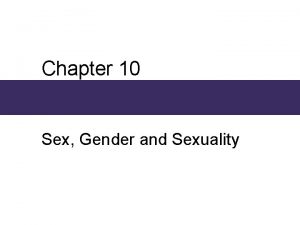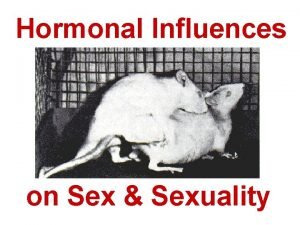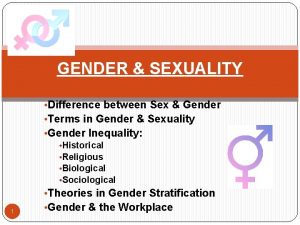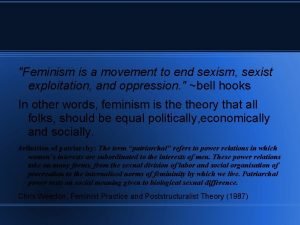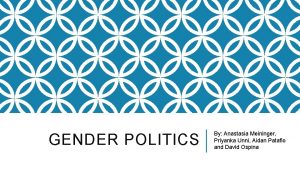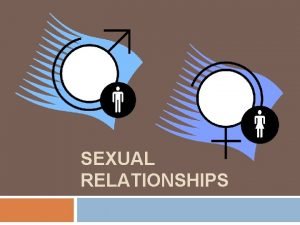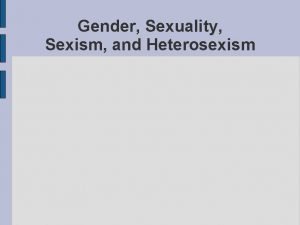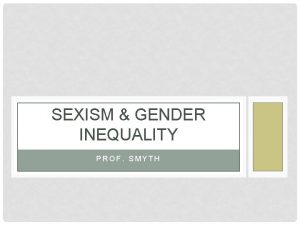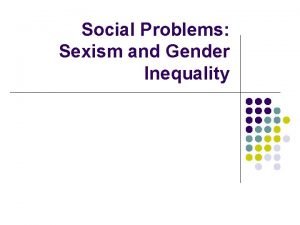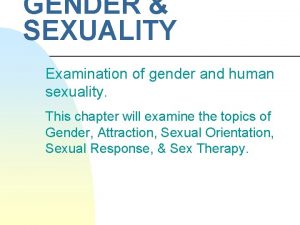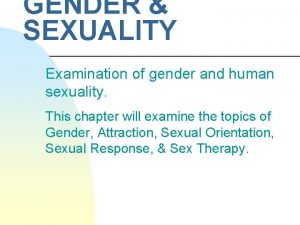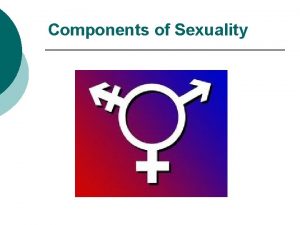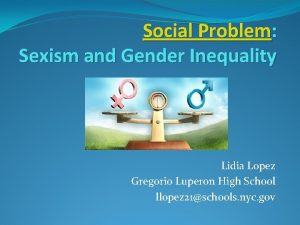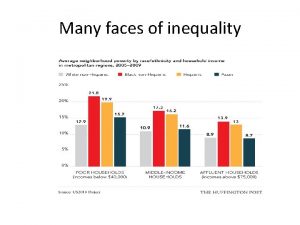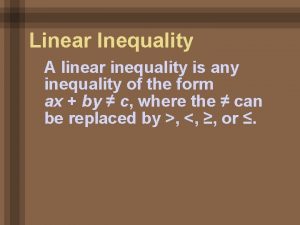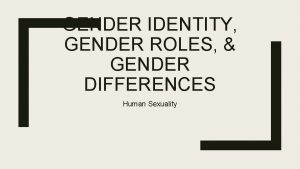Gender Sexuality Sexism and Heterosexism Gender Inequality Gender
























- Slides: 24

Gender, Sexuality, Sexism, and Heterosexism

Gender Inequality ● ● Gender stratification refers to the ranking of the sexes in such a way that women have unequal power, opportunities, and resources. It is one thing to acknowledge differences, and different roles, it is another thing to rank those “differences” in relation to each other. What is feminine is inferior, and what is masculine is superior. Gender inequality exists in most parts of the world today. Gender inequality is often justified by people and institutions, based on what they say are biological differences btw men and women.

Theoretical Approaches ● ● ● Lorber and Allen both talk about this, and Allen criticizes uses only this approach to understand gender inequality. Gender Roles Approach – This approach emphasizes the socialization process through which we all learn to perform our masculinity and/or feminity. Gender Structure Approach – this approach looks at how gendered inequality is structured into everyday lives. Gender is something that goes beyond individual actions.

Social Construction of Gender Differences ● ● ● Society transforms biological females and males into social actors that perform their gender. Masculinity and Femininity are not going to be shaped the same way in every circumstance/culture. There is variation in how boys and girls are treated and trained. This varies between cultures, with a culture over time, over the course of individuals lives, and btw and among different groups of women and men depending on race, class, gender, ethnicity, nationality, and ability.

Gender as a Process - Lorber ● ● ● Gender as a process creates and maintains social differences that define “woman” and “man”. In almost every social interaction we engage in, we are performing the gendered “acting” that we have learned. We produce, and reproduce gender as a process Gendered behavior is enacted through the way we express our sexuality, through the way we parent, through the way we express ourselves at work. . .

Learning Gender ● ● ● At home – family strongly influences how we learn and understand gender At play – toys are important socializing agents. . . Formal Education – curriculum, textbooks, teacher/student intersections, sports, female role models, counseling services. . . Interactions with peers The media The church

Reinforcing Male Dominance – Micro level interactions ● ● Verbally – Through language we learn and reinforce a partriarchal culture. Men are referred to as studs, dudes, jocks vs bimbos, girls, and chicks. What is the differences between the meanings of these words? Interpersonal behavior - nonverbal – guys interrupt girls more frequently, guys speak longer and more in public. . .

Reinforcing Male Dominance – Meso Level Institutions ● ● ● Media - Women are less represented in film; the ways that women are portrayed is often degrading; there is little complexity in the roles that women play. Men's roles are also limited. This varies substantially by race, class, sexuality, nationality, etc. Religion – Clergy are generally male, the holy books prescribe different roles for men and women, women are subordinate to men. The Law – Women were not allowed to vote, sexual discrimination was only recently acknowledged, intra marital rape was only recently criminalized. . .

Reinforcing Male Dominance – Meso Level Institutions ● ● Politics – Women are increasingly involved in politics, but the gap is still large. In the state capital, women are 60% of the labor force, however, these jobs are often undervalued and their role as workers is invisibilized. Medicine – Insurance routinely refers to pregnancy as a “disability” (rather than an ability), traditional women healers have been historically criminalized – midwifery and home birth are still illegal in many states. The medicalization of child birth has become something that gives a male dominated profession power over something that has historically been a woman's work.


Patriarchy, The System - Culture ● ● Culture is used to provide and perpetuate symbols and ideas about what is “real”. Patriarchy is a set of symbols and ideas that make up a culture – these permeate our everyday lives. Patriarchal culture uses a complex web of ideas to explain what is real. These cultural ideas define what is good and desirable. It establishes the rules we are all supposed to live by. These rules range from the formal – legal rules adopted by the government, to the informal – maybe even illegal rules that everyone understands as “normal”.

Patriarchy, The System - Culture ● ● ● Gaining and exercising control is the highly valued in patriarchy. Power in patriarchal culture means having “power over” other people, resources, and events. . . Power over (masculine) is thought of as good in patriarchy and to lack such power (feminine), is considered weak. Cultural ideas – about the nature of men and women. Where men and masculinity are what makes up humanity and women and femininity are “other”. Cultural Expectations – of how social life is supposed to be and about how people are supposed to feel. Cultural Standards – of feminine beauty, submission, and vulnerability and masculine toughness, domination, and protectiveness. Cultural Importance – of men's careers and women's childbearing.

Patriarchy, The System - Culture ● ● ● ● Patriarchal culture perpetuates the idea that: there are two and only two distinct genders. heterosexuality is normal and natural and that homosexuality is not. Men cannot feel compelled to love and nurture children. Women, whether they identify as straight, bisexual, or lesbian all want a real man who knows how to take charge. Females cannot be trusted, especially when they are menstruating or when they are accusing men of sexual misconduct or abuse. Patriarchal culture normalizes misogyny.

Patriarchy, The System - Culture ● ● The symbols and ideas of patriarchal culture are important to understand because they powerful effects on the structure of social life. Social life is structured by a system that privileges some over others. . . Social life is structured so that resources are distributed unevenly. The structure of patriarchy is found in the unequal distribution of power that makes oppression possible, in patterns of male dominance in every facet of life, from conversation to global politics.

Gender – Stratification System ● ● ● Resources are distributed based on gender (and race, class, sexuality, nationality. . . ) Men are ranked above women. In a Gender stratified society, men's work is more valued than women's work. The more economic resources that are available to a group, the more they are monopolized by men. Being a man doesn't always work in favor of men though. . . depending on one's race and class, how they are perceived by others and how many resources are available to them will change.

Gender - Structure ● ● Gender as a structure divided men's work and women's work into public and private. Gender divides work in terms of economic production – who gets paid to do what? Gender as a structure legitimates those in authority, and it legitimates the unequal distribution of resources. As a structure, gender organizes sexuality. . . and how people are supposed to feel about their's and others' sexuality.

Gender and Power ● ● Gendered Institutions means institutions (family, church, medicine, higher education) are patterned by gender. These institutions maintain gender inequality. Men are not all dominant all of the time. Many men have power over other men. What we tend to accept as legitimate differences between men and women, are used to normalize and justify men's domination of women. Patriarchy is the system of domination where men dominate women.

Patriarchy, The System ● ● ● We all participate in something larger than ourselves, that we didn't create, but that we help maintain through how we choose to participate in the system. Patriarchy is more than individual men. It is a system, and it cannot be reduced to the individuals who participate in it. We tend to see sexism as a problem in the way individuals were trained to see themselves and to treat each other. That might partly explain sexism, however it does not completely explain how gender oppression occurs systematically.

Patriarchy, The System ● ● The Status Quo – the normal functioning of the system. . . the thing that everybody is doing, without really questioning. Maintaining the status quo is the easiest thing to do in a system of oppression. Resisting the system is more difficult. Talking about gender socialization helps us understand part of how the status quo is maintained, but it talking about gender socialization does not offer us a solution to change patriarchy – the system. To understand patriarchy, we have to look at the cultural ideas taught to and performed by men and women, the web of relationships that structures life, and the unequal distribution of rewards and resources that underlies oppression.

Structured Gender Inequality. Work ● ● ● Since 1980, women have taken over 80% of the new jobs. Women and men are still clustered into different kinds of work. Women are more likely to fo clerical work, to be an elementary or highschool teacher, or to be a nurse. They are less likely to become lawyers, doctors, and professors. . . jobs which have historically been held by men. Women do the “background” unrecognized work. White women are much more likely to move into jobs historically held by white men. They have been the only group of people to noticeably benefit from affirmative action.

Structured Gender Inequality. Work ● ● Women earn 77 cents for every dollar men earn; for women of color the gap is greater. If women earned as much as men, their annual salary would increase by $4, 000 on average and the rate of poverty would be cut in half. Women earn less than men b/c they: are concentrated in lower paid jobs, enter the workforce at lower paying levels than men, have less education and experience than men, tend to work less overtime than men. Despite these factors, women with the same credentials as men still earn less. Sex discrimination in the job market blocks women from higher paid positions.

Structured Gender Inequality. Race and Gender ● ● ● Women of color make up over 10% of the US workforce. Women of color are concentrated in the more domestic, more “private” and feminine work. Mexican American women - secretarial, cashier, and janitorial jobs; Central American women – domestic cleaners, janitors, and textile machine workers; Filipinas – nurses, nurse aides, cashiers; Black women – nurses, nurses aides, cashiers. More white women (38%) occupy managerial and professional specialty jobs than Black women (30%) and Latinas (21%).

Structured Gender Inequality. Race and Gender ● ● ● The labor market is divided into 2 segments – The primary market has jobs that are stable, have promotion ladders, have high wages, have opportunities for advancement. The secondary market has jobs that are unstable, have low wages, fewer opportunities for advancement, and poor working conditions. Women's work is concentrated in the secondary labor market The “glass ceiling” refers to the invisible forces that block women's advancement in the white collar workforce.

Ideological Racism and Cultural Resistance ● ● ● In his article, Espiritu argues that racist, sexist, and homophobic imagery has been used to reinforce US/white cultural dominance. Which social institution does he focus on in his article? What does he mean when he writes about “Yellow Peril”? What are some of the stereotypes our culture has of Asian men? How is this related to ideals of white male sexuality? What are some of the stereotypes our culture has of Asian women? How is this related to ideals of white male sexuality?
 Chapter 10 sex gender and sexuality
Chapter 10 sex gender and sexuality Sex
Sex The difference between sex and gender
The difference between sex and gender The balcony scene romeo and juliet
The balcony scene romeo and juliet Write a compound inequality as an absolute value inequality
Write a compound inequality as an absolute value inequality Lion king sexism
Lion king sexism What is sexism
What is sexism 18+sex
18+sex Sexism in sexist photo
Sexism in sexist photo Pretest growth development and sexuality
Pretest growth development and sexuality Conclusion of gender inequality
Conclusion of gender inequality Methodology of gender inequality
Methodology of gender inequality Gender inequality in politics
Gender inequality in politics Claudia padovani unipd
Claudia padovani unipd Gender inequality quiz
Gender inequality quiz Spoken poetry examples
Spoken poetry examples Strategic gender needs and practical gender needs
Strategic gender needs and practical gender needs Sexuality in advertising
Sexuality in advertising Jowelle de souza
Jowelle de souza Awareness, acceptance and comfort with one’s own body
Awareness, acceptance and comfort with one’s own body Definition of sexuality
Definition of sexuality Definition of sexuality
Definition of sexuality Which illustrates an emotional aspect of teen sexuality?
Which illustrates an emotional aspect of teen sexuality? Peer sexuality support programme
Peer sexuality support programme Base of uterus
Base of uterus
